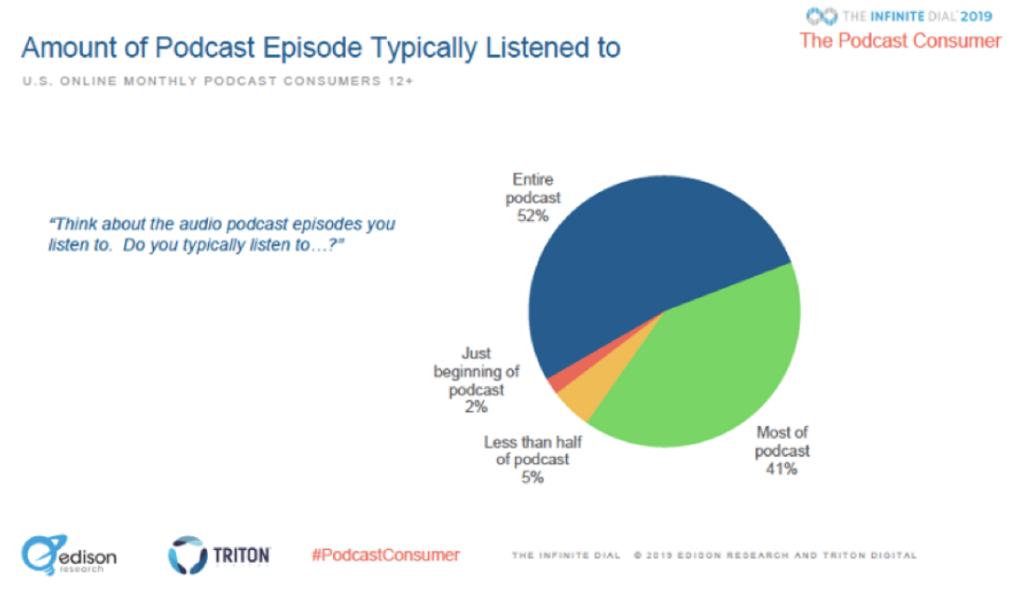Estimated reading time: 4 minutes
Podcasts beating video engagement? Never! I would place bets on the fact that a large number of people arriving on this page will be thinking exactly this, while shaking their heads and tutting under their breath.
I understand why. I did the same before looking through the evidence.
First things first, let’s make one thing clear. We’re not saying video isn’t important (read more about that here). In fact, “86% of marketers say video has helped them generate leads”, so it’s definitely an important part of any marketing strategy.
But this is about highlighting the power of podcasting and how effective it is at engaging an audience. We’re big fans of multifaceted marketing approaches – this isn’t an either-or scenario, it’s about using all the tools at your disposal.
A common belief
While I initially assumed video would be more engaging than audio, it turns out I’m not the only one thinking this. In a study investigating the extent to which delivery mediums affect engagement, “participants self-reported greater involvement for watching video”. However, it turns out these people had a much stronger physiological response to audio. The study explains: “sensors placed at their wrists showed higher and more variable heart rates, greater electrodermal activity, and even higher body temperatures for audio.”
Confused? Well, basically what this means is all those details that videos hand you on a plate – the clothes someone is wearing, the features of their face, the way their hair sits – are giving your brain an easier journey than audio would. As the report mentions, “watching video is a more passive process due to the fact that there is less scope for personal interpretation.”
Audio on the other hand is therefore a much more imaginative, and potentially engaging, experience.
This starts to make a lot of sense, especially when you take into account research that states around “92 percent of podcasts are listened-to alone“. Podcasting is an intimate medium that really engages your cognitive prowess and has the ability to transport you into a place, situation or conversation.
This also explains why higher completion rates are being seen in podcasts vs. video, with around “93% of podcast listeners completing most or entire episodes (30 minutes or longer).“
Podcasts have more opportunity
It doesn’t stop there though. In fact, things are about to get much more interesting. According to a BBC Global News study, it turns out that “94% of listeners consume podcasts whilst active.” Carrying out chores at home (61%) and driving (55%) were the most common, meanwhile exercising, shopping and running errands were also popular.
This instantly felt relatable to me – it fits my exact listening habits. What I wasn’t expecting was the effect this can have on our retention! Turns out being active while listening increases “engagement (+18%), emotional intensity (+40%) and long term memory of the podcast (+22%).”
There’s real science to all of this that I really won’t pretend to understand. But for all you budding scientists out there, phrases like ‘low-involvement processing’, ‘fuel-efficient’’ and ‘lower cognitive load’ come into the equation.
But regardless of reason, what this research does show as clear as day is that engagement goes up as you listen to a podcast while active, which is absolutely wonderful for a medium that has 3-hour long episodes that continuously perform well.
Podcasts and multitasking
Now, let me ask you a serious question. When was the last time you watched a YouTube video while driving? I really hope the answer to that is never. What about watching a YouTube video while exercising or doing housework? How often are you giving a video your full attention whilst being active?
Most likely, you spend much less time completing tasks while consuming video. But podcasts on the other hand, well, that’s another story. Many of us listen to audio while driving, working out, cleaning the house – and not only does this open up plenty of opportunities to listen to podcasts, but doing so doesn’t appear to significantly affect our engagement.
Shorter videos vs. longer audio
As we said at the start, we are by no means trying to say that video isn’t important. Video is certainly valuable in its own way. But the reality is that “shorter videos hold viewers’ attention the most“.
Videos that are less than 90 seconds long had a completion rate of 59% in 2017, up from 53% in 2016. That compares to a 14% completion rate for the longest videos (at least 30 minutes). This puts podcasts in an incredibly unique position because, in contrast to video, people are listening for much longer periods of time. People are engaging for the duration of an in-depth conversation. The research is clear and the power this translates to in terms of marketing and branded content is unparalleled.
Want to learn more about the benefits of starting a branded podcast? Read more here.

